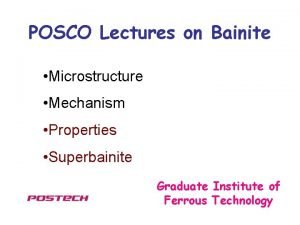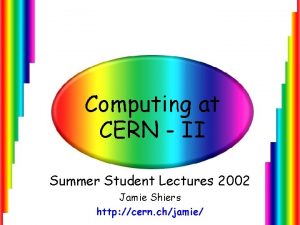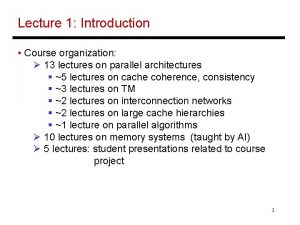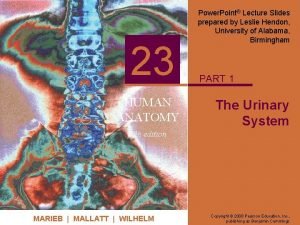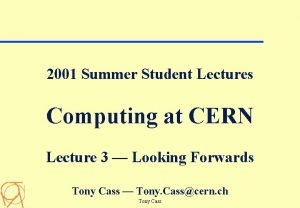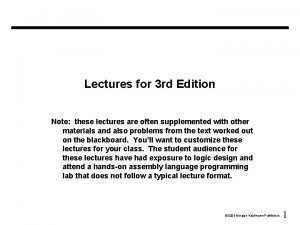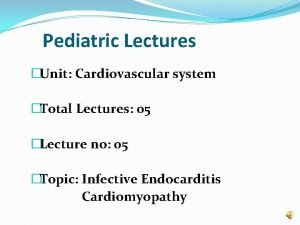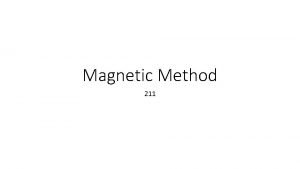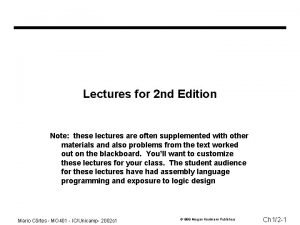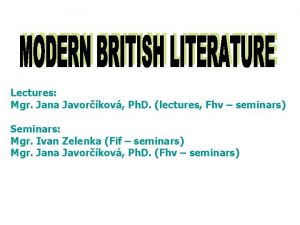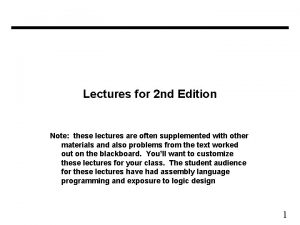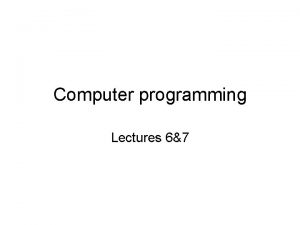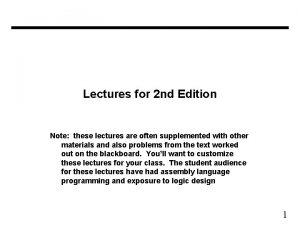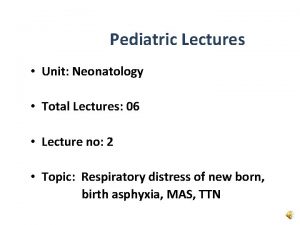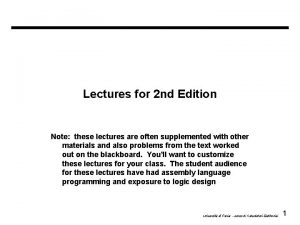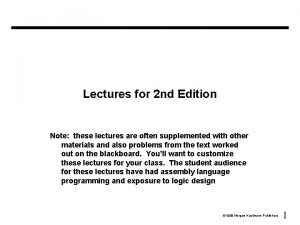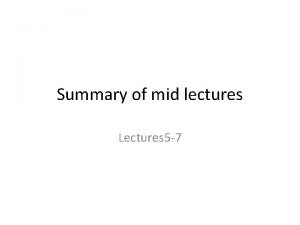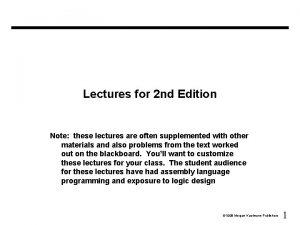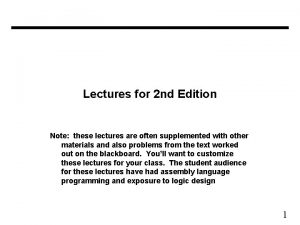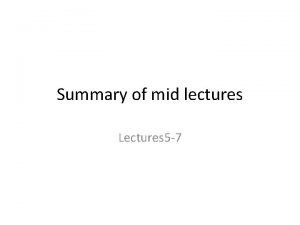Lectures PoMonday 9 00 10 40 A 11














































- Slides: 46

Lectures: Po/Monday 9: 00 – 10: 40 A 11 Room 234 Practicals: Út/Tuesday 10: 30 – 13: 00 Microscopic hall of the Dept. 30 31 32 33 Recommended web-address: http: //www. med. muni. cz/histol/vyukac. htm Literature for study:

Basic Histology The Developing Human

2008 ISBN: 978 -1 -4160 -3705 -7 Before We Are Born, 7 th Edition - Essentials of Embryology and Birth Defects With STUDENT CONSULT Online Access By Keith L. Moore, BA, MSc, Ph. D, FIAC, FRSM and T. V. N. Persaud, MD, Ph. D, DSc, FRC Path(Lond) 368 pages 1308 ills ($54. 95, Softcover)

Lecture 1 ESS_3 rd semester Outline of development of the digestive system – a revision GENERAL STRUCTURE OF THE ALIMENTARY CANAL (MICROSCOPIC STRUCTURE OF THE ORAL MUCOSA) MICROSCOPIC STRUCTURE OF THE ESOPHAGUS, STOMACH, AND SMALL AND LARGE INTESTINE HISTOPHYSIOLOGY OF THE INTESTINE AND BLOOD CIRCULATION

Digestive system consists of the alimentary canal - oral cavity, oropharynx, esophagus, stomach, small and large intestines, rectum and anus associated glands - salivary glands, liver and pancreas function is to obtain from ingested food the metabolites necessary for the growth and energy needs of the body food is digested and transformed into small molecules that can be easily absorbed through the lining of alimentary canal

Outline of development of the digestive system Development of the alimentary canal: it constitutes during the 4 th week from 3 separate embryonic anlages (organs): the stomodeum (primitive mouth) – develops on the cephalic end of the embryo, is limited by 5 frominences (frontonasal, 2 maxillary, 2 mandibular) - ectoderm oropharyngeal membrane the primitive gut – arises by incorporation of the dorsal part of the yolk sac into embryo during cephalocaudal and lateral folding of the embryo gut is connected to the yolk sac by means of the vitelline (omphalomesenteric) duct - endoderm cloacal membrane the proctodeum (anal pit) - develops on the caudal end of the embryo between future bases of lower limbs - ectoderm

stomodeum oropharyngeal membrane primitive gut foregut midgut ventral mesenterium dorsal mesenterium hindgut cloacal membrane proctodeum

membranes are temporary structures and soon are ruptured – all three segments become continuos Segments of the primitive gut: - foregut - midgut - hindgut is suspended from the ventral and dorsal body wall by mesenteries the dorsal mesentery – caudal end foregut – hindgut the ventral mesentery – shorter during further development midgut rapidly grows in length to form 2 loops (duodenal and umbilical), rotates and leaves even the abdominal cavity (physiological herniation)

after reposition of the herniation midgut occupies its defenitive position

while the ectoderm of the stomodeum and proctodeum as well as the endoderm of the gut differentiate into the epithelium of the alimentary canal, the muscular and fibrous elements + visceral peritoneum derive from the splanchnic mesenchyma that surrounds the lining of the primitive gut Development of associated glands: (salivary glands, liver and pancreas) develop from the endoderm (ectoderm) that gives rise to specific cells (hepatocytes, exo- and endocrine cells of the pancreas (the parenchyma)

DERIVATIVES OF THE PRIMITIVE GUT The foregut: • the pharynx and branchiogenic organs • the lower respiratory tract • the esophagus • the stomach • the duodenum proximal to the opening of the bile duct • the liver and pancreas + the biliary apparatus The midgut: • the small intestines, including the part of the duodenum distal to the opening of the bile duct • the caecum and appendix • the ascending colon • the transverse colon The hindgut: • the descending colon • the sigmoid colon • the rectum • the superior portion of the anal canal • the epithelium of the urinary bladder and most of the urethra

General structure of the definitive alimentary canal Layers of the wall of the alimentary canal: Ø mucous coat - tunica mucosa Ø submucous coat - tela submucosa Ø muscular coat - tunica muscularis Ø serous coat (tunica serosa) or adventitia (tunica adventitia)

Sublayers :


MICROSCOPIC STRUCTURE OF THE ESOPHAGUS, STOMACH, AND SMALL AND LARGE INTESTINE HISTOPHYSIOLOGY OF THE INTESTINE AND BLOOD CIRCULATION

external appearance of the mucosa shows close relation to function of the respective segment folds (transient or permanent) pits – tubular invagination of the epithelium villi – mucosal processes (epithelium and lamina propria)

Esophagus -20 - 25 cm long muscular tube wall consists of 4 layers

Stomach (lat. ventriculus, gr. gaster, stomachus) segment of alimentary canal that digests food and secretes hormones food mixed with gastric juice = chyme volume cca 2 l cardia, fundus+body, pylorus wall shows 4 layered organization: 1. mucous coat (pale, grayish pink) gastric areas (2 -6 mm in d. ) gastric pits (foveolae gastricae) are tiny grooves 2. submucous coat - loose areolar tissue 3. muscular coat - inner oblique - middle circular - outer longitudunal 4. serous coat - peritoneal covering


Cardia ventriculi: a narrow circular band (1, 5 -3, 0 cm in with) at the transition between esophagus and stomach site of change of the epithelium mucous cardiac glands in the lamina propria (mucus + lysozyme)


Fundus et corpus ventriculi:

Fundus et corpus ventricul – gastric areas:

Mucosa of the fundus and body: - simple columnar epithelium - lamina propria mucoae - loose areolar conn. tissue - lamina muscularis mucoae

lamina propria is penetrated with branched tubular glands- gastric (fundic) glands 3 parts: base, body and neck 4 cell types: - chief (pepsinogenic) - parietal (oxyntic, HCl) - mucous neck - enteroendocrine gastric juice

an enzyme typical of oxyntic cells is carbonic anhydrase

Pylorus ventriculi: deeper gastric pits, reticular conn. tissue, pyloric glands

Small intestine (intestinum tenue) 5– 7 m in length digestion, absorption 3 segments: duodenum, jejunum and ileum wall consists of 4 layers: mucous, submucous, muscular a serous coat Surface specialization of the mucosa: 1. plicae circulares (valves of Kerckring) - transverse and permanents folds with submucous core 2. intestinal villi and crypts - villi - finger-like or leaf-like projections 0. 5 -1. 5 mm in length - crypts (of Lieberkühn) - tubular invaginations (0. 5 mm in depth) between bases of villi 3. microvilli - folds of the apical plasma membranes of enterocytes „brush border“ in the LM

circular plicae (valves of Kerckring, plicae circulares) Intestinal villi (villi intestinales) Microvilli

Small intestine - surface circular plicae (plicae of Kerckring, plicae circulares) Intestinal villi (villi intestinales) Microvilli

Intestinal villi (villi intestinales) and crypts of Lieberkühn

tunica mucosa Epithelium - simple columnar Lamina propria mucosae Lamina muscularis mucoase the epithelium: absorptive cells: enterocytes secretory cells: goblet cells, Paneth´s cells, enteroendocrine cells

Paneth´s cells

Intestinal villus (-i)- structure

intestinal villus

Duodenum

Jejunum

BLOOD AND LYMPH CIRCULATION



Large intestine (intestinum crassum) 1, 5 m in length intestinum caecum with vermiform appendix (appendix vermiformis), colon (colon ascendens, transversum, descendens, sigmoideum) and rectum (intestinum rectum) faeces 4 layers: mucous, submucous, muscular a serous coats 1. the mucous tunic is smooth without intestinal villi, but crypts of Lieberkühn are retained, absence of Paneth cells - simple columnar epithelium (enterocytes, goblet cells, endocrine cells) - lamina propria - reticular tissue (lymph nodules) - muscularis mucosae 2. the submucous coat - wide, made up of areolar connective tissue 3. the muscular coat - inner circular and outer longitudina (3 taeniae coli) 4. the serous coat or adventitia (deposits of adipose tissue in the serosa - appendices epiploicae) plicae semilunares : permanent plicae made up of t. mucosa, submucous coat and t. muscularis

the large intestine mucosa:

the mucous tunic

Vermiform appendix


The rectum
 Haematology lectures
Haematology lectures Cdeep lectures
Cdeep lectures Theory and practice of translation lectures
Theory and practice of translation lectures Utilities and energy lecture
Utilities and energy lecture Medicinal chemistry lectures
Medicinal chemistry lectures Bhadeshia lectures
Bhadeshia lectures Reinforcement learning lectures
Reinforcement learning lectures Hegel philosophy
Hegel philosophy Frequency of xrays
Frequency of xrays What is aerodynamics
What is aerodynamics Molecular biology lecture
Molecular biology lecture Pab ankle fracture
Pab ankle fracture Rick trebino
Rick trebino Medical emergency student lectures
Medical emergency student lectures Bureau of lectures
Bureau of lectures Oral communication 3 lectures text
Oral communication 3 lectures text Translation 1
Translation 1 Web engineering lectures ppt
Web engineering lectures ppt Cern summer student lectures
Cern summer student lectures Uva template powerpoint
Uva template powerpoint Ota resident lectures
Ota resident lectures 13 lectures
13 lectures Nuclear medicine lectures
Nuclear medicine lectures Tamara berg husband
Tamara berg husband Radio astronomy lectures
Radio astronomy lectures Anatomy lectures powerpoint
Anatomy lectures powerpoint Lectures paediatrics
Lectures paediatrics Medical hematology student lectures
Medical hematology student lectures C programming lectures
C programming lectures Trend lectures
Trend lectures Digital logic design lectures
Digital logic design lectures Introduction to recursion
Introduction to recursion How to get the most out of lectures
How to get the most out of lectures Comsats virtual campus lectures
Comsats virtual campus lectures Pathology lectures for medical students
Pathology lectures for medical students Cs614 short lectures
Cs614 short lectures Reinforcement learning lectures
Reinforcement learning lectures Gpoint c++
Gpoint c++ Power system lectures
Power system lectures Dr sohail lectures
Dr sohail lectures Cern summer school lectures
Cern summer school lectures Data mining lectures
Data mining lectures Rcog cpd portfolio
Rcog cpd portfolio Theory of translation lectures
Theory of translation lectures Computer networks kurose
Computer networks kurose Rbc formation stages
Rbc formation stages Frcr physics lectures
Frcr physics lectures





